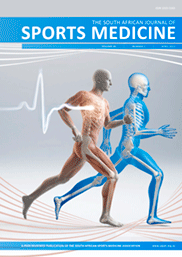The prevalence of self-reported neck pain in rugby union players in Gauteng Province
DOI:
https://doi.org/10.7196/SAJSM.512Keywords:
Rugby, Neck pain, PrevalenceAbstract
Background. Rugby is a highly demanding sport that carries a high risk of injury, specifically to the neck region. Repetitive loading of the neck during the scrum or tackle phase may increase neck symptoms and pain.
Objectives. The objective of this cross-sectional, descriptive study was to determine the prevalence of self-reported neck pain in rugby union players in Gauteng Province, South Africa.
Methods. One hundred rugby union players of a mean ± standard deviation age of 22.1±2.4 years, height 1.84±0.07 m and weight 95.3±15.2 kg, completed the four-part questionnaire.
Results. We found a 12% prevalence of current neck pain, and 52% of the players reported experiencing previous neck pain. Neck pain was more frequently reported in forwards, with the tackle being the most commonly stated cause. Eighteen players reported mild to moderate disability as a result of neck pain. The players reported that neck strengthening, on-field treatment and coaching could be improved to prevent neck pain.
Conclusion. Current and previous neck pain is prevalent in rugby union players. Neck pain may be a sign of underlying pathology; therefore, players presenting with chronic or acute neck pain should be assessed thoroughly by a sports physician. Neck conditioning and strengthening should be encouraged in all players to prevent the deleterious effects that rugby union may have on the cervical spine.
Downloads
Downloads
Additional Files
Published
Issue
Section
License
Copyright (c) 2014 South African Journal of Sports Medicine

This work is licensed under a Creative Commons Attribution 4.0 International License.
The South African Journal of Sports Medicine reserves copyright of the material published. The work is licensed under a Creative Commons Attribution 4.0 (CC BY 4.0) International License. Material submitted for publication in the South African Journal of Sports Medicine is accepted provided it has not been published elsewhere. The South African Journal of Sports Medicine does not hold itself responsible for statements made by the authors.
How to Cite
- Abstract 635
- PDF 472
- Tables and Figures 63





.png)